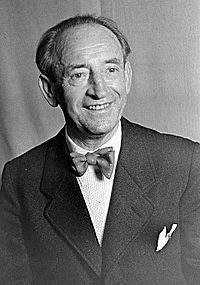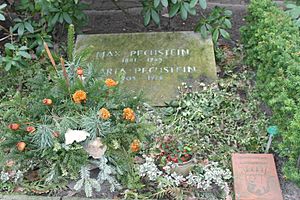Max Pechstein facts for kids
Quick facts for kids
Max Pechstein
|
|
|---|---|

Pechstein in 1946
|
|
| Born | 31 December 1881 |
| Died | 29 August 1955 (aged 73) |
| Education | School of Applied Arts, Dresden; Royal Art Academy, Dresden |
| Known for | Painting, printmaking |
| Style | Expressionism |
| Movement | Die Brücke |
Hermann Max Pechstein (born December 31, 1881, died June 29, 1955) was a famous German painter. He was known for his Expressionist art style. Pechstein was also a talented printmaker and a member of an art group called Die Brücke.
During World War I, he fought as a soldier. Later, his art was sadly called "Degenerate Art" by the Nazis. This meant over 300 of his paintings were taken from German museums.
Contents
Early Life and Art Career
Max Pechstein was born in Zwickau, Germany. His father worked in a textile factory. Max was one of eight children in his family.
He was inspired by the art of Vincent van Gogh early on. This helped him develop his own Expressionist style. Pechstein first worked as a decorator in his hometown.
Art School and Die Brücke
Pechstein later went to the School of Applied Arts in Dresden. Then he studied at the Royal Art Academy there. He met other artists like Otto Gussman and Wilhelm Kreis.
From 1902 to 1906, he was a student of Gussmann. In 1906, Pechstein met Erich Heckel. Heckel invited him to join the art group Die Brücke. Pechstein was the only member who had formal art training.
He was an active member of Die Brücke until 1910. He often worked with other Brücke painters. This helped create a similar style among them. In 1905, he saw wood carvings from the South Seas at a museum in Dresden. This inspired him to create his first woodcut print.
Travels and New Art Groups
In 1907, Pechstein traveled to Italy for an award. In 1908, he visited Paris. There, he met the Fauvist painter Kees van Dongen. Pechstein convinced him to join Die Brücke.
Later that year, Pechstein moved to Berlin. Other Brücke painters also moved there in the next few years. In 1910, his art was not accepted for an exhibition in the Berlin Secession. So, he helped start a new group called the New Secession. He became its chairman.
Pechstein became known for his colorful prints. These were inspired by artists like Van Gogh and Matisse, and the Fauves art movement.
Leaving Die Brücke
In 1912, Pechstein was removed from the Brücke group. This happened because he showed his art alone in the Berlin Secession. He did not include paintings from other members.
This was not a sad event for Pechstein. He was getting more awards and recognition than his friends. His art style was more traditional, which appealed to more people. This success, however, caused some tension with the group.
His paintings later became more primitivist. They featured thick black lines and sharp, angular shapes. He traveled to Palau in the Pacific ocean to find new inspiration.
World War I and Later Life
When World War I began, Pechstein was in Japan. He was held there for a short time. He returned to Germany by traveling through Shanghai, Manila, and New York. In 1916, he was sent to fight on the Western Front (World War I).
After the German Revolution of 1918–19, Pechstein joined two socialist groups. These were the Arbeitsrat für Kunst and the November Group (German). In 1922, Pechstein became a professor at the Berlin Academy.
Art Under the Nazis
Starting in 1933, the Nazis disliked Pechstein's art. They called it "degenerate." He was not allowed to paint or show his art. He was also fired from his teaching job that year.
A total of 326 of his paintings were taken from German museums. Sixteen of his works were shown in the Entartete Kunst (Degenerate Art) exhibition in 1937. During this time, Pechstein lived quietly in the countryside of Pomerania.
After 1945, he was allowed to paint again. He received many awards for his work.
Art Restitution
Many of Pechstein's art collectors were Jews. Their art collections were taken by the Nazis. In 2013, the Bavarian State Painting Collections agreed to return two of Pechstein's paintings. These were White House (1910) and Meadow Valley (1911). They were given back to the family of Curt Glaser. In 2021, France also returned a Pechstein painting called Nus dans un paysage to the family of Hugo Simon.
Pechstein was a very productive printmaker. He made 421 lithographs, 315 woodcuts and linocuts, and 165 intaglio prints. Most of his intaglio prints were etchings.
Personal Life
Max Pechstein was married to Charlotte Karpolat from 1911 to 1923. He later married Marta Möller. He passed away in West Berlin. He is buried in the Evangelischer Friedhof Alt-Schmargendorf in Berlin.
Works
See also
 In Spanish: Max Pechstein para niños
In Spanish: Max Pechstein para niños




